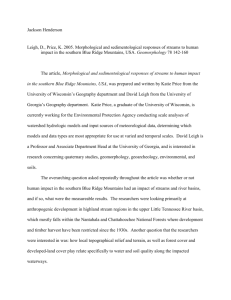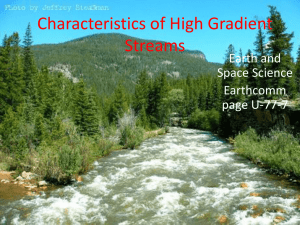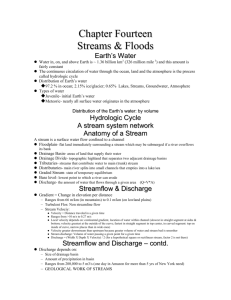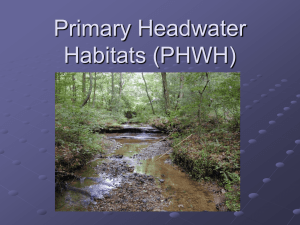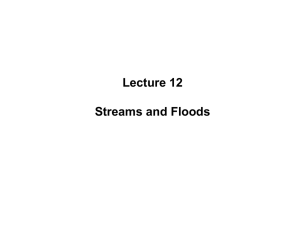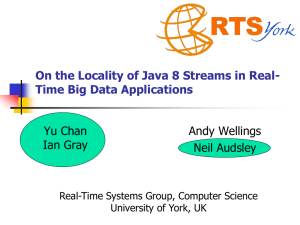Lab 7 Lecture
advertisement
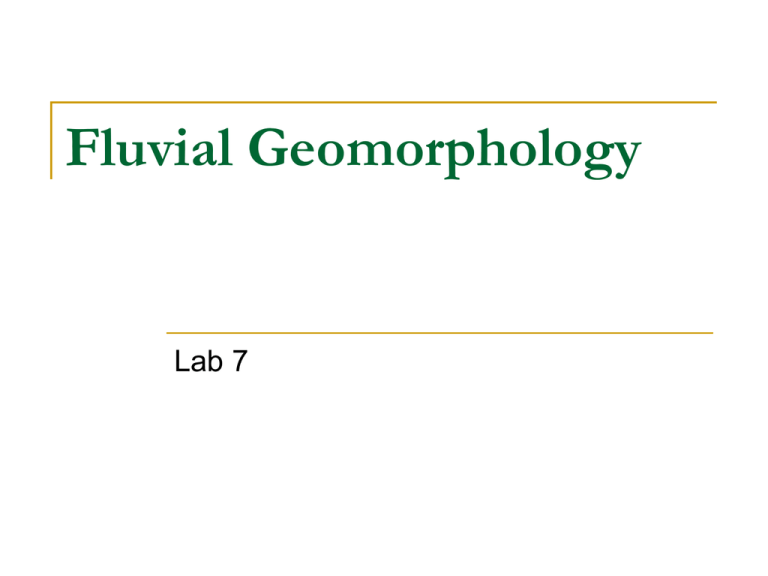
Fluvial Geomorphology Lab 7 Concepts Basic concepts and definitions Watersheds/Drainage Basins Drainage divides Drainage patterns Classifying stream order Categories of rivers Types of work performed by streams Alluvium Base level Straight channel, braided stream, meandering stream Stream information Calculating discharge Flood recurrence Real-world example: Midwest Floods of 1993 Real-world example: Water Wars affecting Georgia Basic Concepts & Definitions Fluvial = stream-related processes Geomorphology = analysis of how landforms evolve Fluvial Geomorphology is important in understanding how water shapes our earth Basic Concepts & Definitions Types of work performed by streams 3 types of work: Erosion of landscape Streams carry mixture of water and solids Alluvium = clay, silt, and sand that is transported & deposited by running water Transportation of materials Deposition of materials Concept of “Base Level” Lowest (elevation) point to which a stream can flow and cut down to Ultimate base level = sea level Watersheds/Drainage Basins Streams organized into areas called watersheds or drainage basins. All the water in the area flows into one stream and exits in one spot. Can be broken down into sub-basins (see map of Georgia). Watersheds/Drainage Basins Watersheds are separated from others due to drainage divides High ground which separates streams that are flowing in adjacent basins. Streams cannot cross the divide. Watersheds/Drainage Basins Drainage Patterns Within each watershed, streams develop into distinct patterns due to the underlying geology. 7 common patterns: Dendritic Rectangular Trellis Radial Parallel Deranged or Chaotic Centripetal Watersheds/Drainage Basins Drainage Patterns Centripetal Watersheds/Drainage Basins Classifying stream order Classify patterns of streams in a basin “First-order” streams are smallest Any basin will have more first-order streams than any other category. Think of these as headwater streams. Where 2 similar-ordered streams come together, they increase in order. 1&1=2 2&2=3 3&3=4 2 streams of same order must be joined to increase in order. Otherwise, keep the higher number for the next stream. 1&2=2 1&3=3 2&4=4 5 & 12 = 12 Watersheds/Drainage Basins Classifying stream order Categories of Streams Straight Channel Uncommon, usually only occurs in canyons or when humans force rivers to straighten out Examples: portions of the Columbia River (states of Washington and Oregon) and the Colorado River (southwest U.S.) Categories of Streams Braided Stream Forms when the stream cannot hold its sediment load and dumps it in the middle of the channel. Channel bars are collected piles of sediment Channel bars force the river to flow around them, which separates the river into “braids” Categories of Streams Braided Stream example: Platte River Notice the channel bars? Some of them are even covered in vegetation, and have wildlife living on them! These are considered established channel bars and do not easily reshape. Categories of Streams Meandering Stream Sinuous channel Form through deposition and lateral erosion Deposition = inside bank (slower velocity water allows alluvium to collect here) Erosion = outside bank of the meander (higher velocity water erodes the bank) Categories of Streams Meandering Stream: common features Point Bar Cut Bank Cutoff Oxbow Lake Backswamp Meander Scar Floodplain and its features Levee Yazoo stream Categories of Streams Meandering Stream: common features Why streams meander The fastest water in the channel moves from side to side. Check out the blue line: this is the path of the fastest water, which is why erosion takes place there. Cut Bank Erosion taking place on the outside of the meander. Point Bar Look at the deposition on the right side of the photo. Categories of Streams Meandering Stream: common features (oxbow lake formation) Categories of Streams Meandering Stream examples: Chattahoochee, Mississippi, Tennessee Stream Information Calculating discharge Velocity = how quickly water is moving through the stream Discharge = volume of water transported by a stream Area (A) = Width (w) x Depth (d) The greater the discharge, the more ability it has to carry sediment In times of flooding, discharge is higher than during periods of infrequent/low precipitation. Need to know velocity & area of the stream’s channel. If w = 5 feet, d = 4 feet, then A = 20 ft2 Discharge (Q) = Velocity (v) x Area (A) If v = 100 ft/s and A = 20 ft2, then Q = 2000 ft3/s Stream Information Calculating discharge: effects of urbanization Less infiltration water can’t soak into pavement… More runoff More flooding Specific causes: Deforestation Construction and paving Channelization (restricting the channel by building man-made levees) Stream Information Floodplains Floodplains form when the river leaves its channel during times of high flow. Natural levees are produced from flooding Flood waters overflow the banks, river loses velocity as it spreads out. It dumps its sediment load, which forms the levees. Yazoo streams may form on the other side of levees – cannot join the main channel because of the levee. Stream Information Floodplains: Flood recurrence Recurrence = average time period when an event will be equaled or exceeded Likelihood of occurrence each year Used to designate different flood zones (1 ÷ Frequency) x 100 “10 year flood” = (1 ÷ 10) x 100 = 10% 10% chance that a flood will occur each year by that stream If a 10 year flood happens in 2007, it still has a 10% chance to occur in 2008, 2009, 2010… Does not mean that another flood cannot happen for another 10 years! 10 year 100 year 500 year Stream Information Example: Midwest Floods of 1993 Most devastating flood in recent US history ($20B in damages), 14 weeks of flooding. Towns relocated rather than rebuilt! Estimate that this was beyond a 100 or 500 year flood… perhaps a 1,000 year flood! Can you calculate the likelihood of that type of flood? Stream Information Example: Water Wars of the ACT and ACF Tri-state water fight ACF = Apalachicola, Chattahoochee and Flint ACT = Alabama, Coosa, and Tallapoosa Fights due to conflicting water needs Georgia: needs for urban areas and farming Alabama: fears GA is hogging water Florida: oyster fisheries in Apalachicola Bay is suffering since water is being held back in GA and AL Read more about the water wars: www.metroatlantachamber.com/macoc/initiatives/img/tri-statefactsheet.pdf
